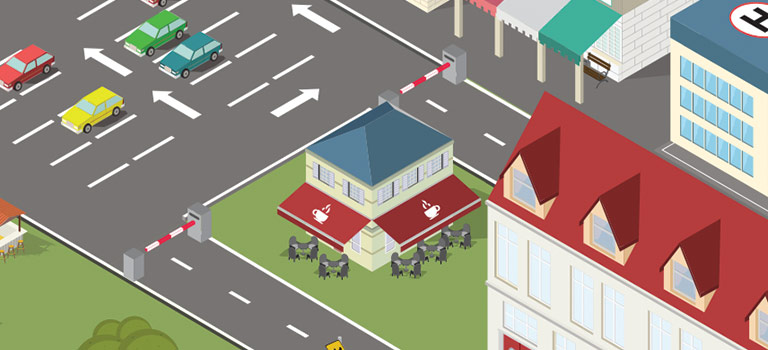Roadmap to Success
Becoming engaged in an effort to improve community health can be challenging for employers, especially if the effort is new. The HWHC Roadmap to Success offers insight into those stakeholder groups that are often part of a community collaboration and describes the roles those stakeholders play. In addition, we point to case studies that highlight the roles of each stakeholder highlighted on the map. To use the map, scroll over each icon to learn more about that stakeholder audience.

Health Care
Health systems, hospitals and provider clinics are an integral part of every community. These stakeholders also have a deep commitment to the health of a community and are often the primary convener for many employer-community collaborations. In addition to a deep knowledge of health, this stakeholder group brings knowledge of measures, research and funding to an effort. This group also has high credibility in the community and can encourage other important stakeholders to become engaged in an effort. See the Kaiser Permanente case study for a great example of healthcare partnering in healthy community efforts.

Large Business
Typically over 1000 employees, these businesses include both local and international companies that may or may not be headquartered locally. Engaging a large business to be an advocate for a healthy community effort can lead to stronger engagement overall from this group. This stakeholder group can be the leader of a healthy community effort and can be a funding source as well. Both the Disney and Walmart case studies highlight the efforts of large businesses in healthy community efforts.
.

Midsize Business
Midsize businesses (over 100 employees) often include grocery stores, larger retail stores, etc. and make up about one-third of the business in the United States. These companies often have employee health and wellness programs and look to the community as a resource pool to fill positions in their workforce. Not unlike small businesses, the midsize business network is a strong network that can be an advocate for healthy community efforts. The case study from the Mid-America Coalition on Health Care highlights efforts by small and midsize businesses in healthy community work.

Small Business
Local and small business stakeholders make up a large part of a community’s business sector. These stakeholders are an important part of the community and can contribute greatly to a healthy community effort. In addition, the small business network is a strong network that can be a part of disseminating the messages of the community effort. The case study from the Mid-America Coalition on Health Care highlights efforts by small and midsize businesses in healthy community work.

K-12
Education is a key part of the community and often one of the largest employers in a community as well. Specifically, K-12 education is often involved in employer-community collaborations, recognizing that health and wellness of the community directly impacts the student population. In particular, nutrition and physical activity are two common priorities for this stakeholder.

Higher Education
Stakeholders representing higher education can be leaders in employer-community collaborations because of their access to research and measure experts as well as their experience with accessing resources such as grants. Higher education often takes on the role of researcher or evaluator for community efforts. In addition, higher education institutions are often large employers that bring a great deal of knowledge to an initiative from their own health and wellness employee programs.

Philanthropy
Community philanthropy, most often in the form of foundations, can be a great source of short and long term funding for healthy community efforts. In addition to funding, this stakeholder group has knowledge about other funding sources and can help an employer-community collaboration develop a sustainable funding strategy. The work of The California Endowment highlights the role philanthropy can play in healthy community efforts.

Nonprofits
Nonprofit stakeholders in the community are deeply committed to the health and welfare of the community. They often have very defined missions that can be an important contribution to the overall goal of an employer-community collaboration. Engaging nonprofit stakeholders will ensure that efforts are not duplicated and that there is continuity in the approach and programs offered to community residents. This stakeholder group brings in-depth knowledge of funding sources and community needs to the initiative as well. Several case studies in the HWHC Case Studies library highlight non-profit led community efforts…these include Partnership for a Healthier America and Healthy Weight Commitment Foundation.

Community Development
Economic development and other organizations focused on reinvigorating a community in some way can be an important partner in a healthy community effort. The Live Well Omaha case study offers insight into the role community development can play in healthy community efforts.

Government / Public Health
Government/public health stakeholders, at all levels, have a responsibility for the health and welfare of the community. In addition, public health stakeholders do have access to a variety of data and information at the community level related to health and risk. For example, this stakeholder group often has access to community-wide needs assessment that can be one piece of information used to develop a healthy community strategy. Lastly, government and public health stakeholders work in the community and have a deep knowledge of the community makeup and many community connections that are important to the success of a healthy community effort.


Health Care
Health systems, hospitals and provider clinics are an integral part of every community. These stakeholders also have a deep commitment to the health of a community and are often the primary convener for many employer-community collaborations. In addition to a deep knowledge of health, this stakeholder group brings knowledge of measures, research and funding to an effort. This group also has high credibility in the community and can encourage other important stakeholders to become engaged in an effort. See the Kaiser Permanente case study for a great example of healthcare partnering in healthy community efforts.

Large Business
Typically over 1000 employees, these businesses include both local and international companies that may or may not be headquartered locally. Engaging a large business to be an advocate for a healthy community effort can lead to stronger engagement overall from this group. This stakeholder group can be the leader of a healthy community effort and can be a funding source as well. Both the Disney and Walmart case studies highlight the efforts of large businesses in healthy community efforts.
.

Midsize Business
Midsize businesses (over 100 employees) often include grocery stores, larger retail stores, etc. and make up about one-third of the business in the United States. These companies often have employee health and wellness programs and look to the community as a resource pool to fill positions in their workforce. Not unlike small businesses, the midsize business network is a strong network that can be an advocate for healthy community efforts. The case study from the Mid-America Coalition on Health Care highlights efforts by small and midsize businesses in healthy community work.

Small Business
Local and small business stakeholders make up a large part of a community’s business sector. These stakeholders are an important part of the community and can contribute greatly to a healthy community effort. In addition, the small business network is a strong network that can be a part of disseminating the messages of the community effort. The case study from the Mid-America Coalition on Health Care highlights efforts by small and midsize businesses in healthy community work.

K-12
Education is a key part of the community and often one of the largest employers in a community as well. Specifically, K-12 education is often involved in employer-community collaborations, recognizing that health and wellness of the community directly impacts the student population. In particular, nutrition and physical activity are two common priorities for this stakeholder.

Higher Education
Stakeholders representing higher education can be leaders in employer-community collaborations because of their access to research and measure experts as well as their experience with accessing resources such as grants. Higher education often takes on the role of researcher or evaluator for community efforts. In addition, higher education institutions are often large employers that bring a great deal of knowledge to an initiative from their own health and wellness employee programs.

Philanthropy
Community philanthropy, most often in the form of foundations, can be a great source of short and long term funding for healthy community efforts. In addition to funding, this stakeholder group has knowledge about other funding sources and can help an employer-community collaboration develop a sustainable funding strategy. The work of The California Endowment highlights the role philanthropy can play in healthy community efforts.

Nonprofits
Nonprofit stakeholders in the community are deeply committed to the health and welfare of the community. They often have very defined missions that can be an important contribution to the overall goal of an employer-community collaboration. Engaging nonprofit stakeholders will ensure that efforts are not duplicated and that there is continuity in the approach and programs offered to community residents. This stakeholder group brings in-depth knowledge of funding sources and community needs to the initiative as well. Several case studies in the HWHC Case Studies library highlight non-profit led community efforts…these include Partnership for a Healthier America and Healthy Weight Commitment Foundation.

Community Development
Economic development and other organizations focused on reinvigorating a community in some way can be an important partner in a healthy community effort. The Live Well Omaha case study offers insight into the role community development can play in healthy community efforts.

Government / Public Health
Government/public health stakeholders, at all levels, have a responsibility for the health and welfare of the community. In addition, public health stakeholders do have access to a variety of data and information at the community level related to health and risk. For example, this stakeholder group often has access to community-wide needs assessment that can be one piece of information used to develop a healthy community strategy. Lastly, government and public health stakeholders work in the community and have a deep knowledge of the community makeup and many community connections that are important to the success of a healthy community effort.